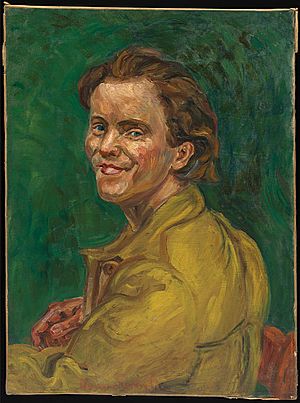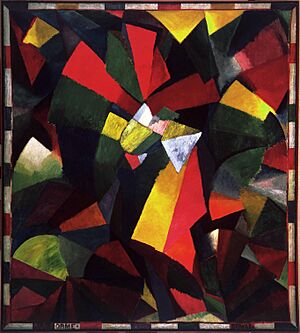Morgan Russell facts for kids
Quick facts for kids
Morgan Russell
|
|
|---|---|

self-portrait c. 1907
|
|
| Born | January 25, 1886 |
| Died | May 29, 1953 (aged 67) |
| Nationality | American |
| Known for | Painting |
| Movement | Synchromism |
Morgan Russell (born January 25, 1886 – died May 29, 1953) was an important American artist. He helped create a new style of art called Synchromism. This art style used colors in a special way.
Russell started Synchromism with another artist, Stanton Macdonald-Wright. They created this style between 1912 and the 1920s. Russell's "synchromies" were paintings that used color like music. They were an early part of Modernism in American art. Modernism was a big change in art.
Contents
Early Life and Art Studies
Morgan Russell was born and grew up in New York City. He first studied how to design buildings. Later, he became friends with a sculptor named Arthur Lee. Russell even posed as a model for Lee's sculptures.
From 1903 to 1905, Russell studied sculpture. He went to the Art Students League of New York. In 1906, he got help from Gertrude Vanderbilt Whitney. She was a big supporter of his art. With her help, he traveled to Europe. He studied art in Paris and Rome.
In 1907, Russell came back to New York City. He studied painting there. One of his teachers was Robert Henri. Henri was a famous painter from the Ashcan School. In 1909, Russell went back to Paris. He studied at Matisse’s art school. He also met famous artists like Picasso and Rodin.
Creating Synchromism

In Paris, Russell met Stanton Macdonald-Wright in 1911. They were both American artists living abroad. Soon, they started to develop new ideas about color. They believed color was the most important part of art.
Many young artists at that time felt that traditional art was boring. Russell and Macdonald-Wright wanted to create art that didn't just show real things. They were interested in a teacher's ideas. This teacher, Percyval Tudor-Hart, thought colors could be arranged like notes in a song.
Russell and Macdonald-Wright were inspired by other artists. These included Delacroix and the Post-Impressionists. They also liked the Fauves. In 1912, Russell and Macdonald-Wright started Synchromism.
Their first Synchromist art show was in June 1912. It was in Munich. Four months later, they had another show in Paris. They also wrote a statement about their art goals. They wanted to make a big splash in the art world. Russell also began showing his art at the Salon des Indépendants in 1913.
Synchromism and Other Artists
Synchromism was a new kind of abstract art. Abstract art does not show real objects. Russell mainly developed this style. Macdonald-Wright also helped a lot. Other American painters in Paris tried Synchromism too. These included Thomas Hart Benton and Andrew Dasburg. They were friends with Russell and Macdonald-Wright.
Some people thought Synchromism was similar to Orphism. Orphism was another art style. It was created by Sonia and Robert Delaunay. Some people even said Russell and Macdonald-Wright copied Orphism. But both artists strongly denied this.
Challenges and Later Recognition
Russell and Macdonald-Wright hoped to become famous. They also wanted to sell many paintings. They brought Synchromism to New York. Russell showed his art in the famous Armory Show in 1913. He also showed it in the Forum Exhibition of Modern American Painters in 1916.
However, their hopes were not fully met. Before World War I, art collectors were not ready for abstract art. They preferred European modern art. These European artists were already well-known.
A book called Modern Painting: Its Tendency and Meaning helped Synchromism. It was published in 1915. The author was Willard Huntington Wright. He was a famous writer and art critic. He praised Synchromism in his book. He said it was a very important art movement. This book helped bring some attention to Russell and Macdonald-Wright.
By 1920, Russell and Macdonald-Wright went their separate ways. Macdonald-Wright moved back to California. He became a successful artist there. Synchromism was not often talked about in art books. It didn't have big art shows until the late 1950s. Russell's art shows were rare.
Russell lived in France for almost 40 years. He returned to the United States in 1946. In 1947, he became a Catholic. He had two strokes and died in 1953. He was 67 years old. He passed away in a nursing home near Philadelphia.
Later in the 20th century, people started to pay more attention to Synchromism. The Whitney Museum of American Art had a big art show in 1978. It showed color abstract art. This brought Russell's name back into public view.
Morgan Russell's first special museum show was in 1990. It was at the Montclair Art Museum in New Jersey. Today, his art is in many important museums. These include the Museum of Modern Art and the Brooklyn Museum. His large painting, Synchromy in Orange: To Form (1914), is very famous. It was a main part of a big show in 2013. This show was called "Inventing Abstraction, 1910–1925."
Images for kids
See also
 In Spanish: Morgan Russell para niños
In Spanish: Morgan Russell para niños



